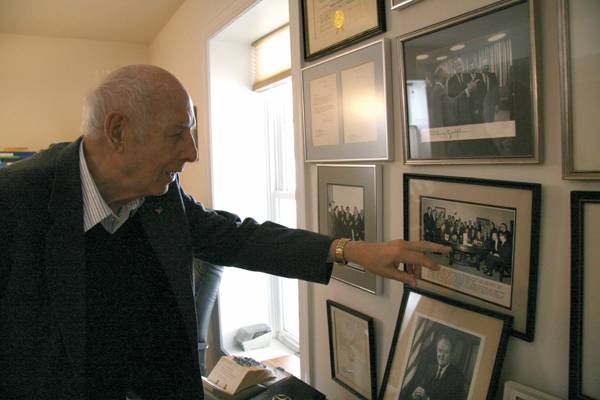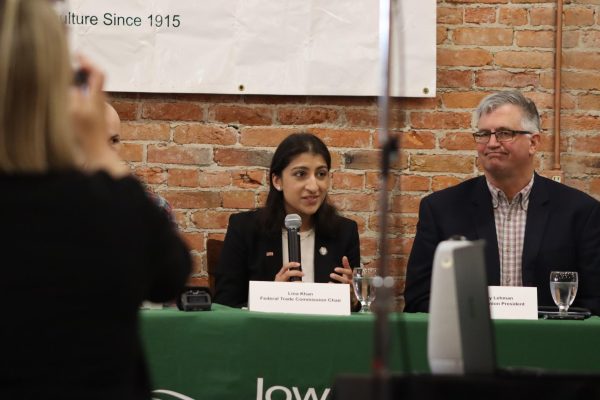ISU alum Dwight Ink reflects on a life of opportunities

Dwight Ink in his home in his home in Lansdowne, Virginia. Photo: Sarah Haas/Iowa State Daily
March 23, 2010
Editor’s note: This is the first part in a three-part series detailing ISU alumnus Dwight Ink’s career serving as a public administrator. The first part relays Ink’s experiences working at the Atomic Energy Commission, while the second part includes Ink’s employment under Presidents Richard Nixon and Ronald Reagan. The final installment discusses Ink’s lasting relationship with Iowa State.
When Dwight Ink first met a U.S. president, he was clutching information more top secret than the director of the CIA could access.
Carrying two locked containers housing charts that explained the future plans of the Atomic Energy Commission during the Cold War, Ink was escorted into an unremarkable room of the White House for his first of what would become many White House meetings.
He memorized combinations that unlocked each container. The charts not only included a description of the contents of the U.S. nuclear stockpile but also the newest technical developments the AEC hoped would keep the United States ahead of the Soviet Union in the nuclear arms race.
The sensitivity of the information was so high that the AEC could not risk putting the information together in one chart.
“I walked into this office alone and put the cases down and looked up and there was this bald guy behind a big desk looking at me. He asked me, ‘What’s your name?`’ and I stumbled and said, ‘My name’s Dwight.’ And he said, ‘My name is Dwight, too.’”
Unexpectedly alone in the Oval Office with the president, the combinations to the locked charts quickly vanished from Ink’s memory. His boss, John McCone, was late for the meeting with the president. Noticing Ink’s anxiety, President Dwight Eisenhower asked where Ink was from.
“I’m from Iowa,” Ink said to the president.
Born Sept. 9, 1922 in Des Moines, Ink was one of the first two ISU students to graduate with a degree in government in 1948. After receiving a master’s degree in public administration, Ink spent more than 30 years working as a public administrator and served seven presidents.
Eisenhower coaxed Ink into remembering the combinations by talking about Big Six football. Eisenhower, who was from Kansas, was familiar with Iowa State and even mentioned a recent ISU victory.
Eventually Ink was able to open both cases and set up the charts. He eased into the presentation, during which time his boss joined the pair and allowed Ink to proceed with the briefing.
Eisenhower was the first of seven presidents for whom Ink worked. In addition to playing an integral role in the AEC, Ink helped to create the Department of Housing and Urban Development, deconstruct Community Service Administration and rebuild Alaskan communities shaken by the 1964 earthquake.
Throughout his career, Ink maintained his hard-working, modest countenance that made him successful as a college student in Ames.
At 87, he lives with his wife, Dona Wolf, outside Washington, D.C., in Lansdowne, Va.
“His accomplishments are truly unique. That’s exactly how I would describe them,” said James McCormick, chair and professor of political science. “To be a trusted adviser to seven presidents is an extraordinary feat, which is quite telling of Dwight’s character.”
Ink was recently honored for his service in a book published in November. “If We Can Put a Man on the Moon: Getting Big Things Done in Government,” by William D. Eggers and John O’Leary devoted an entire chapter to Ink’s ability to be successful in a variety of different positions while working for administrations with widely varying ideologies.
“The thing I don’t know how to express is they were, none of them, experiences that required any brilliance,” Ink said. “It was just plain, ordinary work.”
His willingness to learn the complexities of problems allowed Ink to enjoy success early in his career. After working in local government and federal government field offices, Ink was brought to the attention of the federal government after he helped to expedite construction of the most critical project in the free world, the Savannah River Plant in South Carolina in 1952.
Ink was able to find a job heading the department of statistics at the plant after successful stints serving as assistant city manager of Fargo, N.D., heading a new Bureau of Reclamation program and working for the AEC in a community development program in Oak Ridge, Tenn.
“I didn’t even like statistics,” he said. “I didn’t have expertise in the subject matter despite the efforts of Professor [George] Snedecor at Iowa State, though my lack of knowledge turned out to be my salvation.”
At the time, the AEC wasn’t solely concerned with creating weapons. The agency also maintained that atomic energy promised to be a source of cheap energy. There was also hope that atomic energy could be applied effectively to medical problems.
“It was still quite a new agency at the time with an exciting and challenging mission,” Ink said. “We all agreed that if the Soviet nuclear capabilities surpassed those of the United States, then Western Europe would be done for. What that would do to us in the long term from an economic standpoint greatly concerned people. Some predictions were pretty dire, but anyone you talked to would regard it as having very serious consequences for the United States.”
Met with a bevy of problems at the Savannah River Plant, Ink had joined a project that had fallen behind and was undergoing seven different investigations from congressional committees and the White House. Ink tried to organize more detailed data on staffing, materials and money spent in order to understand why the project was delayed.
“None of the data matched up. I thought it was my misunderstanding, not a fault of the system, so I went out into these areas and talked to the foremen and check on the data that was coming in,” Ink said.
He spent nearly 10 months working with the plant contractor employees to determine how money, materials and employees could be better coordinated to move more smoothly. The changes implemented by contractors ultimately culminated in the project getting back on schedule.
“That brought me to the attention of the federal government,” Ink said. “Part of this was because I wasn’t very smart and had gone down to talk to the foremen and the lower level workmen to see for myself what the problems were.”
He spent nearly three years heading the reports and statistics branch and was eventually asked in 1958 to serve as executive assistant to the chairman of the AEC, John McCone, one of the most respectable government figures Ink has encountered. After McCone’s departure in order to become the director of the CIA in 1961 where he helped President John F. Kennedy with the Cuban missile crisis, Ink continued to serve as the assistant general manager of the AEC, which included frequent trips abroad to check on custody of U.S. nuclear weapons at NATO bases.
On one such trip in 1963, Ink sat alone in a West Berlin subway, confined helplessly to his car as he realized that he, a top official in the AEC, had just entered East Berlin behind the Iron Curtain. He said it was one of the most terrifying moments of his life.
Ink had been trying to reach the American airport in West Berlin when he unknowingly boarded a subway that would cross the iron curtain.
“I had been shown movies smuggled from Soviet torture chambers about what the Soviets might do to me if I were captured in an effort to gain important information. I assumed that if any East German police were to find me I would be unheard from again,” Ink said.
Somewhere below East Berlin, an armed guard boarded Ink’s train. He walked directly in front of Ink, the lone occupant of the car, and stopped. Clutching a German newspaper upside down, Ink awaited arrest. Neither of the men said a word. The guard then began to walk in a circle around the empty seats until he finally exited.
“I think pacing gave him time to think of what to do. When he left, I knew he was going to get someone to come and get me,” Ink said.
But the car finally lurched forward and Ink did not encounter another soul until the train returned to West Berlin.
“I have no idea who he was, and I am grateful to him,” Ink said.
His work with the AEC would only come to an end when the great Alaskan earthquake of 1964 required President Lyndon Johnson to appoint him director of the urgent effort to recover from the quake’s devastating 9.2-magnitude.
The life of Dwight Ink
Sept. 9, 1922 – Born in Des Moines
August 1940 – Enrolled at Iowa State
1942-1946 – Served in the U.S. Air Force
1948 – Graduated from Iowa State
1949 – Graduated from the University of Minnesota
1976-1980 – Director of Office of Sponsored Research and Continuing Education, the American University
1973-1976 – Deputy Administrator of the General Services Administration
1969-1973 – Assistant Director for Executive Management, Office of Management and Budget
1966-1969 – First Assistant Secretary for Administration, Department of Housing and Urban Development
1959-1966 – Executive assistant to the chairman of the U.S. Atomic Energy Commission
- Assistant General Manager, U.S. Atomic Energy Commission. He was Assistant to the Chairman of the AEC in 1958-59; Management Assistant in 1955-58; Chief, Reports and Statistics Branch, Savannah River Operations Office, in 1952-55; and program analyst, Office of Community Affairs, Oak Ridge Operations Office, in 1951-52.
- Ink is a recipient of many awards, including the Flemming Award for Ten Outstanding Young Men in Government, U.S. Chamber of Commerce, 1961; Career Service Award, National Civil Service League, 1966; Distinguished Service Award, U.S. Atomic Energy Commission, 1966; and Commissioners Award for Distinguished Service, Civil Service Commission.
- Ink was graduated from Iowa State University (B.S.) and the University of Minnesota (M.A.). In 1942-46 he served in the U.S. Air Force.
- Ink is married and resides in Washington, D.C.
- He was born Sep. 9, 1922, in Des Moines.
















